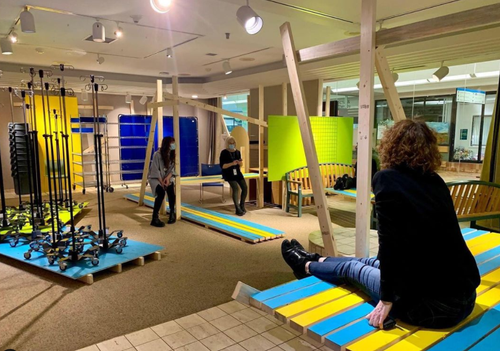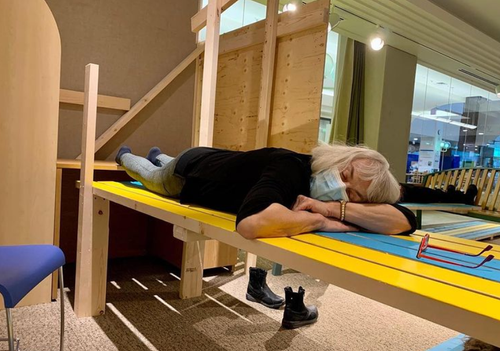An Installation by José Luis Torres
March until July, 2022
About the Artist: José Luis Torres
Artist José Luis Torres’ installations invite viewers to not only see the spaces they inhabit in new ways, but also to playfully interact with these spaces. Torres challenges conventional exhibition standards through what he terms a “make do with” attitude. His materials are often everyday objects that have been repurposed to emphasize their value as witnesses of history. Through his art, Torres explores the fundamental and incidental status of objects, evoking the construction and deconstruction of their identity simultaneously.
Collaboration and spontaneity are key features of Torres’ work. He creates a dialogue between his work and its location by manipulating and re-configuring objects, but also by working closely with the organizations that host his pieces. The goal of these collaborative projects is not to create a specific final form but is instead aimed at representing the action of creation itself.
José Luis Torres was born in Argentina and has a Bachelor’s Degree in visual arts, a Master’s Degree in sculpture, and training in architecture. Torres has been living and working in Quebec since 2003 and has been showcased in many solo and group exhibitions in Canada, Argentina, the United States, Mexico and Europe.
“Halfway between interior and exterior, between nature and culture, between temporary and permanent, recover, refocus, rebuild creates a space for questioning our reality and its’ fragility and instability, thus confirming the human capacity to adapt.” - José Luis Torres
Q&A with José Luis Torres
Creator of Recover, Rebuild, Refocus
What initially interested you about McMullen Gallery and having your work in that space?
This exhibition allows me to establish an unprecedented collaboration with McMullen Gallery, the community of the University of Alberta Hospital, medical staff, and to reach new audiences with the local population by highlighting a new place for the dissemination of my work.
This fun and friendly installation adapts to this public space at the same time as it emerges from the landscape like an oasis of colors. It offers a real experience on a human scale that is in harmony with the principles of simplicity, and offers passers-by an aesthetic experience.
We had to delay your project due to Covid - thank you for waiting patiently for a year a half! Did your initial plan for McMullen Gallery change over time and due to Covid?
The public places of our cities are the bonds of our communities. They create a sense of belonging, interdependence and social cohesion, they promote our collective identity despite our differences. The COVID-19 pandemic has imposed significant constraints on the access and use of these spaces in our communities. The impacts of the virus are diverse, highlighting inequalities between people and disproportionately affecting people already in vulnerable situations.
But, on the other hand, in times of crisis, collective demonstrations of compromise of all forms become a necessity. Opportunities to connect with something bigger than yourself are important to seize. Designed around the notion of accessibility, inclusion and openness, this project offers a glimpse of the current health crisis as a creative opportunity, bringing hope, by inviting citizens to reclaim their public space through art and design.
Collaboration is a big part of your work – you are great at bringing people together. Can you explain why this is important to you and what you create?
The notion of spontaneous gesture are omnipresent in my projects. Each of my projects is a series of placements where objects become actors in their own right. Several objects, selected for their specific shapes, colors and textures, will constitute the materials of each creation.
The community dimension of each installation will be promoted, which is why each work is produced with the involvement of individuals and organizations. The whole creative process is an invitation to reflect on time passing and what remains.
Please explain the title, which is very poignant in the context of Covid and the hospital.
Recover, refocus, rebuild questions the relationship between habitat (shelter, territory), which implies stability, and that of encampment, which implies a state of vulnerability. In the exhibition, the use of repurposed objects (shelving, screens, IV stands) generate associations with the notion of constructing and deconstructing a human identity. And, in this case, the work reiterates the paradigm of life, understood as a phenomenon in perpetual mutation. Like a nomad, the visitor will wander inside an architectural universe under construction or in “deconstruction”. A work inspired by a construction site represents transformation and adaptation.
Halfway between interior and exterior, between nature and culture, between temporary and permanent, recover, refocus, rebuild creates a space for questioning our reality and its’ fragility and instability, thus confirming the human ability to adapt.



To read the full Q&A with José, click the button below for a PDF verson.


